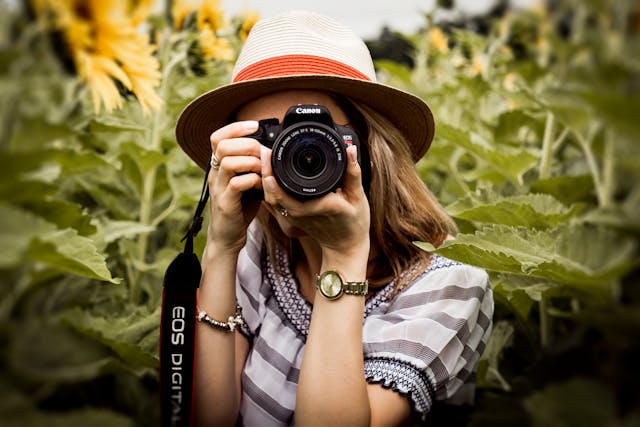
How does autofocus work? Active autofocus works by calculating the distance to the object and passive autofocus works by using contrast sensors to analyze the image.
How does a camera focus? Cameras focus in the same way that our eyes do. Light waves are reflected off objects and they enter our eyes or a camera. The light waves converge on the retina at the back of our eyes, or the light sensitive part of the camera. However, light travels in a straight line and the light would focus in front of the light sensitive part or behind the light sensitive part of the camera, depending on the distance and the angle. The image we are looking at is much larger than the size of the retina or the light sensitive part of the camera. This would make the image very blurry. To bend the light and make all of the light converge in just the right place, we use lenses in our cameras, and in our eyes. There are two kinds of lens shapes we can use. Convex lenses are thicker in the middle than they are at the edges. When the light waves hit them, they are directed inwards, narrowing down the image we are looking at and making it focus in front of where it would naturally fall. We can use these to make images smaller than they are, such as looking at a view. Concave lenses are narrower in the middle than they are at the edges, and they bend the light outwards, making it fall behind where it would naturally fall. We can use these lenses to make small images much larger than they are, such as looking at flowers. A lot of cameras use a combination of the two lenses to get perfect pictures. Focusing works by physically moving the distance of the lens from the light sensitive part of the camera, changing where the light waves converge. You obviously cannot change the shape of the lens in the camera, so by twisting the lens you can move it forwards or backwards.
Up until 1986, the only way to focus a camera was manually. In 1986, the first automatic focusing camera was introduced by the Polaroid Corporation. It used sonar to work out the distance to the object being photographed and altered its own lenses. The camera would send out a sound wave, and measure how long it took to come back, working out the distance from that. A motor in the camera then adjusted the lenses to match this distance. It was a good start to the technology, but there are a lot of problems with it. The sound wave could get swamped, it doesn’t work if you are moving, and it can’t go through windows. This is an active autofocus system because it works out the distance to the target and adjusts the lenses automatically. Today’s active autofocus systems use infrared because the wave is much faster, and it can pass through glass. The problem with these types of cameras is that they have trouble focusing if there are other very bright sources of light or if there is something else in front of the target, like bars in a zoo cage.
Passive autofocus systems don’t send out any light to measure the distance, they analyze the image the camera can see. They have an algorithm that looks for intensity differences between parts of the image. A camera with passive autofocus has a strip of pixels that are connected to the processor. This strip is called a charge-couple device (CCD) and it is about 200 pixels wide. When you try to focus on a flower, for example, the microprocessor in the camera looks at the image that is falling on the CCD and moves the lenses back and forth. The algorithm is looking for a clear break in the intensity of the colors and shades. If the image is out of focus, the colors and shade will blur into each other. If the image is in focus, there will be a clear line where one color or shade ends and another starts. This tells the microprocessor if the image is in focus or not. The microprocessor needs to have details and color contrasts to be able to work all of this out. If there is not enough detail, there won’t be any intensity differences and it will get stuck.
There is evidence for lenses going back to 2700 BC, but that could be circumstantial. Some of their properties were known about in the 1st century AD. They were first used to make images in telescopes in 1608 and in the first simple camera in 1550. Camera lenses have evolved a lot, but it is generally agreed that you need lenses to take photos. Well, it turns out that you don’t. We have looked at different ways of auto focusing, but there are cameras in development that don’t use lenses. Lenses are expensive and they prevent the camera from becoming very small. In modern technology, we need smaller and smaller cameras and that’s hard with a lens. The new generation of camera uses a sensor to detect the light from the image you are trying to take a photo of. The device looks at the encoded pattern and a mathematical algorithm in the microprocessor turns it into an image. They are not perfect yet, but they are improving rapidly. The end of the lens and the autofocus could be close. And this is what I learned today.
Photo by Andre Furtado: https://www.pexels.com/photo/selective-focus-photography-of-woman-holding-dslr-camera-1264210/
Sources
https://www.bhphotovideo.com/explora/photography/tips-and-solutions/how-focus-works
https://www.titech.ac.jp/english/news/2022/063969
https://www.sciencedirect.com/science/article/pii/S2667325824001328
https://www.cambridgeincolour.com/tutorials/camera-autofocus.htm#google_vignette
https://electronics.howstuffworks.com/autofocus.htm
https://byjus.com/physics/difference-between-concave-convex-lens
https://groups.google.com/g/rec.photo.equipment.35mm/c/gSe38F8LxsQ?pli=1
https://www.adorama.com/alc/slr-vs-dslr-whats-the-difference

Pingback: How does a telescope work?